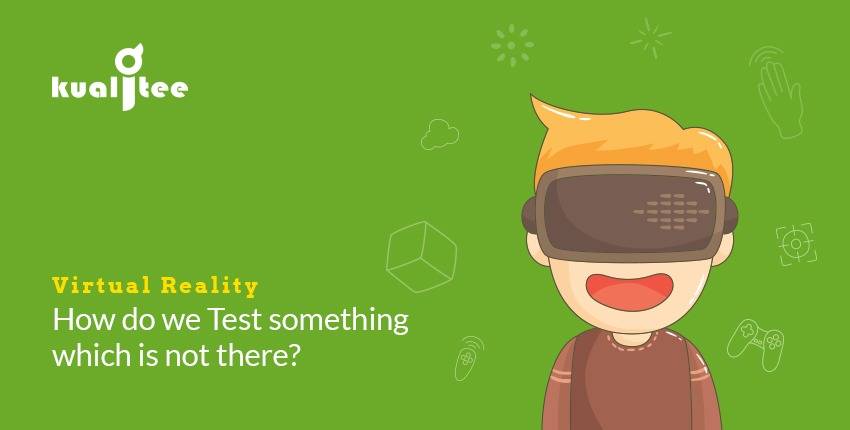Future of Software Testing
As we mentioned earlier in our update that we will be putting up some interesting blogs regarding “Future of Software Testing” and how testers can gear themselves for the upcoming age of a new and smart world.
Following is the first blog in this 3 part series.
Testing Virtual Reality – How do we test something which is not there?
If you belong to a generation born in 70’s and 80’s and has a profound interest in three- dimensional (3D) experience, then you would definitely remember how you came across one in 3D gaming and how it fascinated a whole generation of technologists. We all have witnessed the huge contraption a user has to wear on the head to experience the virtual reality, and those smudged yet beautiful graphical experiences.
If you would remember in 1995, film director Barry Levinson took the world to experience a thrilling ride while portraying the best writing from Michael Crichton in “Disclosure”. Where 22 years ago, for the first time the world witnessed what today Mark Zuckerberg presented a couple of months ago in his VR show for Facebook, this in itself is as amazing as anything we ever experienced so far in computer industry. It is a profound proof that future has already taken its shape and it is now our turn to get ready.
VR – how testers see this?
Before moving further, let’s define what Virtual Reality, really is:
VIRTUAL REALITY – Noun
“The computer-generated simulation of a three-dimensional image or environment that can be interacted with in a seemingly real or physical way by a person using special electronic equipment, such as a helmet with a screen inside or gloves fitted with sensors.” – Source Google.
It is important here to put our perspective in full form, that if we are going to test virtual reality applications we should know how to approach this because, for conventional applications, we have evolved ourselves by the passage of time. Testers have reached an understanding of how to go about for the latter, the former is however still a gray area.
There is no limit to software tester skill sets, in fact, the questionable aspect here is the approach for testing something which is a hybrid of several technologies combined. For testers, we have witnessed the challenges for mobile applications and platforms. Where for even small application, they have to crossover an array of devices, platforms, operating systems, and then test the user experience journey as well.
It is indeed an interesting era of technology we are entering.
The tip of the iceberg:
Software testing companies and testers are now in a realization of the huge shift in perspective of applications.
Here are a few points to note:
- It is not just software that we are dealing with here, it is a complete set of hardware, software, and human configuration mixed together forming a smart monument. This was a similar case when we first experience the desktop computer about 40 years ago, but VR is a whole new set of game-board, and the pieces are just about to set themselves. We need to understand where to place ourselves in this setup.
- Testing a VR technology does not comply with any testing tools right now, so it is all a mix of Black, white, and gray boxes piled together, testers now has to create room for expertise in order to cope up with the changing dimensions. Skeptics would say otherwise, they would argue that you can use tools on the component and wherever the touch-points are interacting with the web, native, or mobile services, but they will not argue with the real experience where a user is experiencing something beyond those platforms and services.
For example, if we start from just the headset, then testing it without wearing it will have a different context, and testing it while wearing it will comply different challenges and context. Same goes with other components which provide experience to user senses but are mere sensory hardware in construction.
- There is also the physical implication that applies because the user, in this case, is unaware of the actual surroundings. Certain videos on social media have shown how users have confronted incidences while experiencing VR.
- User experience is a critical factor here which not only works under the behavioral driven testing, it also complies with the cognitive side as well. For example while testing under this criteria, testers may want to ask these questions:
- How users perceive what they see?
- How real it is? Is the depth of field complies what the actual eye see in real-world?
- Does the user feels elevated in their vitals to a controlled point, or the effects are damaging for the human senses?
We usually don’t ask these questions while testing conventional applications, but VR makes it all turn around the other way doesn’t it?
- On the levels of deeper testing, testers may have to stick to the same principals of exploratory testing and apply and create new heuristics. Even modifying some of the existing heuristics may get the level of required testing for VR.
For example use of product element or Familiarity, Explainability, and World (FEW) as a guideline oracle for defining quality in a VR application and configuration.
Baby steps:
Testers need to approach this with care because they need to understand that whatever they are doing in present for this technology will affect its future. This is a new technology as compared to the desktop computers and mobile applications.
It is also something which is a component of a much larger canvas. The canvas where we can already see Augmented Reality, Internet of things, Security, Performance, and User experience brushing away their textures.
To explore VR in its true form, testers need to take baby steps. They need to understand the relationship of devices, how they are interconnected with each other, the actual experience, and where it is leading to.
Domain Diversity:
Whenever we hear the word “Virtual Reality” the first impression our brain puts up on the visual cortex is a computer game. The reason behind this reflex is simple, it is what has been selling like hot cakes in the past, but that is the “known” part, the “unknown” part of this scenario is now taking a whole new form.
We are now creating maps of infrastructures, complex architectures, and human anatomy to experience and learn about these subjects like never before. The experience, this technology is creating for its users is so rich in its contest that it is working as a market booster for tech products. Already companies with their eyes on future markets shifting their technologies on VR segments.
Get Set Go:
Software testers now need to gear up, they need to make themselves ready for what’s coming their way. To do this, just reading and Googling about this won’t help. Software testing companies, testers, freelancers, and academia, need to equip people with skills that can come handy when the VR apps become as on as mobile applications.
So don’t wait, as the future is already here.
The next blog in this series will be about Healthcare applications, and how testers can test this with gaining domain expertise at the same time.


























